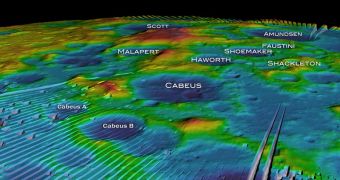In an announcement it made yesterday, the American space agency NASA said that its Lunar Reconnaissance Orbiter (LRO) probe had made an amazing discovery on the Moon – the first signs of water on Earth's natural satellite. After having successfully completed its calibration and fine-tuning stages, the orbiter has begun generating its maps of the Moon, from its high orbit. One of the studies the LRO conducted recently was of space radiation coming from the lunar surface. In this survey, it detected more possible signatures of water than NASA anticipated, Space reports.
“The LRO mission already has begun to give us new data that will lead to a vastly improved atlas of the lunar south pole and advance our capability for human exploration and scientific benefit,” LRO project scientist Richard Vondrak explains. He holds an appointment at the NASA Goddard Space Flight Center, in Greenbelt, Maryland. One of the spacecraft's instruments, the Lunar Exploration Neutron Detector (LEND), has determined that the shadowy and permanently obscured regions of the Moon are highly likely to harbor water ice and hydrogen.
The sensitive instrument assesses decreases in neutron radiation coming in from the Moon in order to determine the existence of water or hydrogen, mission experts say. Vondrak reveals that hydrogen concentrations on the Moon are not necessarily confined to the satellite's shadowy regions. The team behind LRO says that more studies of these finds are in order, before a final conclusion is drawn. “The power of LRO is that we're not just sending one instrument, like LEND, to look for hydrogen, we're characterizing fully” the body's South Pole, the expert adds.
Lunar Orbiter Laser Altimeter (LOLA) measurements conducted recently have also indicated the fact that exploring the South Pole of the Moon will be a far harder task than first thought. The LRO instrument, which precisely maps elevation in the areas it analyzes, has found that the terrain is extremely rough, and that astronauts and vehicles deployed there will have a hard time getting around. One of the orbiter's main purposes is to find places suitable for human landings, as NASA's plans are to put people back on the satellite by 2020. The probe also needs to create the first full maps of the Moon.

 14 DAY TRIAL //
14 DAY TRIAL //